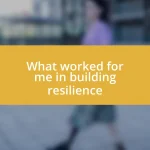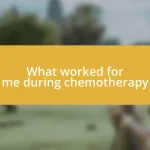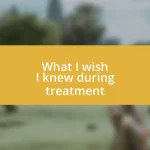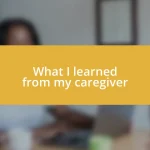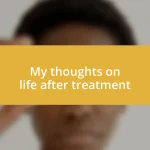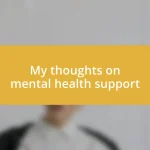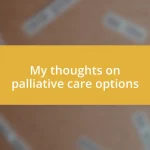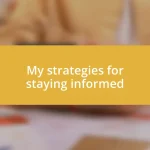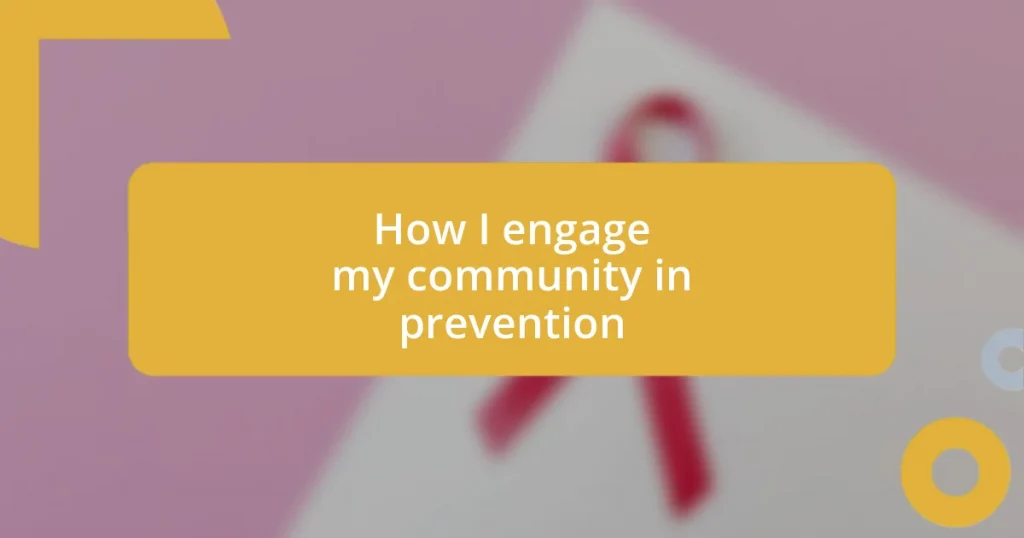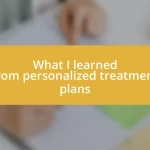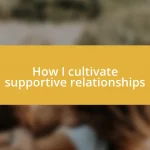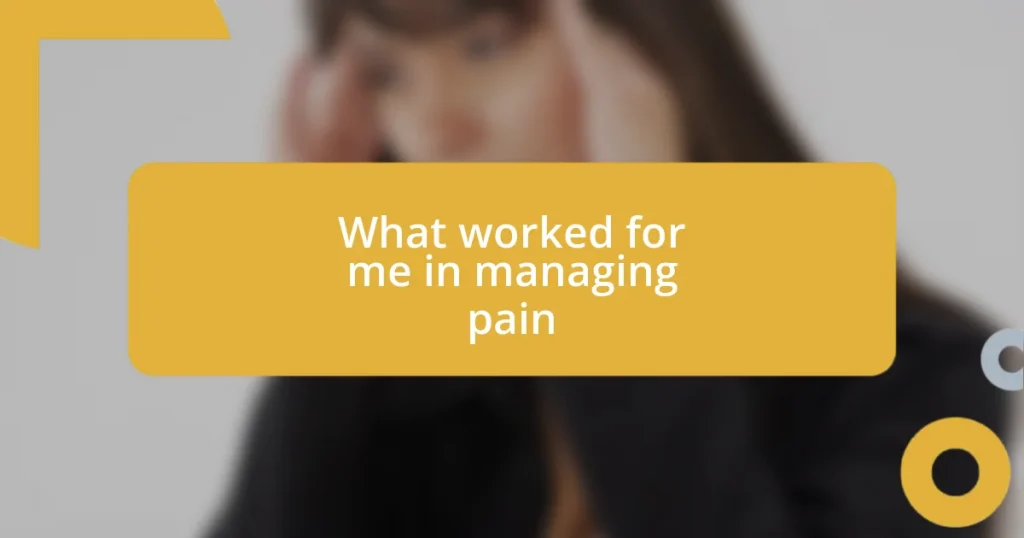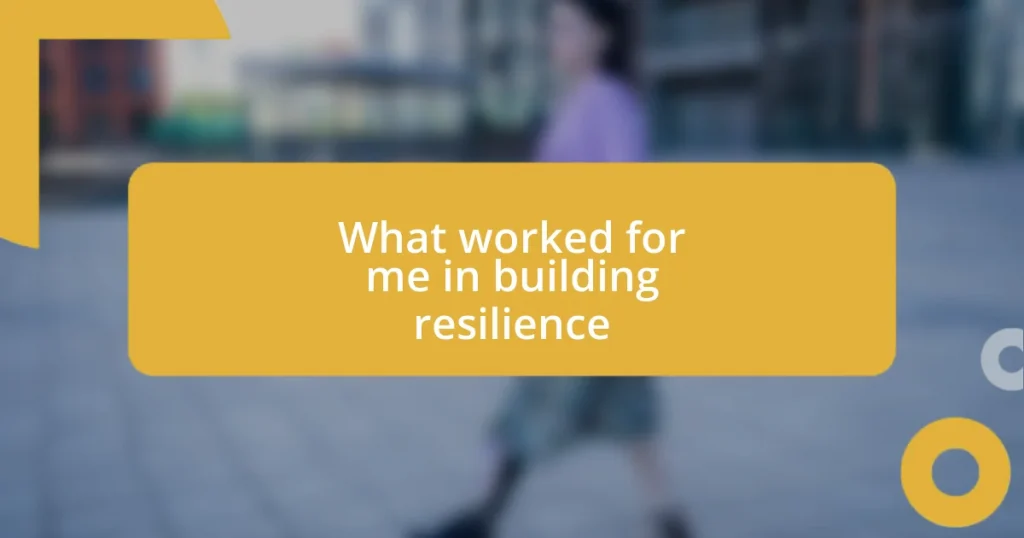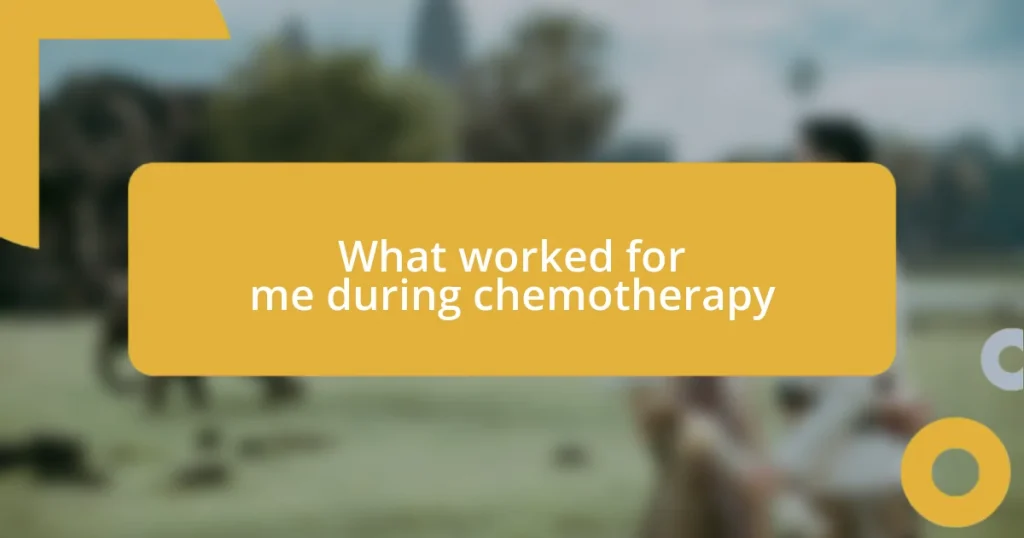Key takeaways:
- Community engagement thrives on meaningful connections, emphasizing the importance of listening to residents and fostering collective ownership of health issues.
- Prevention initiatives not only improve health outcomes and reduce costs but also strengthen community relationships and empower individuals.
- Building partnerships with local organizations enhances resources and ideas, allowing for more effective and inclusive community health initiatives.

Understanding community engagement
Community engagement is all about connecting with people in a meaningful way. I’ve witnessed this firsthand during local health fairs, where individuals from diverse backgrounds come together to learn about prevention strategies. It struck me how powerful it is when a community gathers to discuss common concerns, share experiences, and offer support. Have you ever felt the energy that radiates from a group united by a shared goal? It’s invigorating!
When I think about community engagement, I can’t help but reflect on my own early experiences volunteering for neighborhood clean-up events. Those moments taught me that when people feel valued and heard, they’re more likely to take ownership of collective issues. There’s something transformative about participating alongside your neighbors. You realize that prevention isn’t just about policies; it’s about building relationships.
Listening to community members isn’t just a good practice; it’s essential. I often find that the most effective strategies emerge from conversations where everyone feels included. For instance, during a planning meeting, a resident shared their story about the impact of substance abuse in their family. That honesty opened the floodgates for others to share, and suddenly we were brainstorming solutions together. Isn’t it fascinating how one voice can inspire a chorus?

Importance of prevention initiatives
Prevention initiatives play a crucial role in fostering healthier communities. From my experience, when communities actively engage in prevention efforts, they not only reduce the incidence of health issues but also cultivate a sense of belonging among their members. I still remember the excitement I felt participating in our local vaccination drive; it wasn’t just about the shot, but rather the collective effort to protect one another. It brought a sense of togetherness that is often hard to find.
Here are some key reasons why prevention initiatives matter:
– Healthier Outcomes: By focusing on prevention, we can considerably lower the rates of diseases and health-related issues.
– Cost-Effectiveness: Investing in prevention can reduce healthcare costs in the long run, saving resources for other community needs.
– Empowerment: Engaging individuals in prevention initiatives empowers them, allowing them to take charge of their health and that of their families.
– Strengthened Relationships: These initiatives foster connections among community members, leading to stronger support networks.
– Increased Awareness: They create opportunities for education on important health topics, ensuring everyone is informed and prepared.
Every time I see someone stepping up to share their story or wisdom at these events, it reinforces my belief in the power of prevention. It’s heartwarming how these moments can ignite passion and prompt action, showing us all that together, we can create a healthier future.
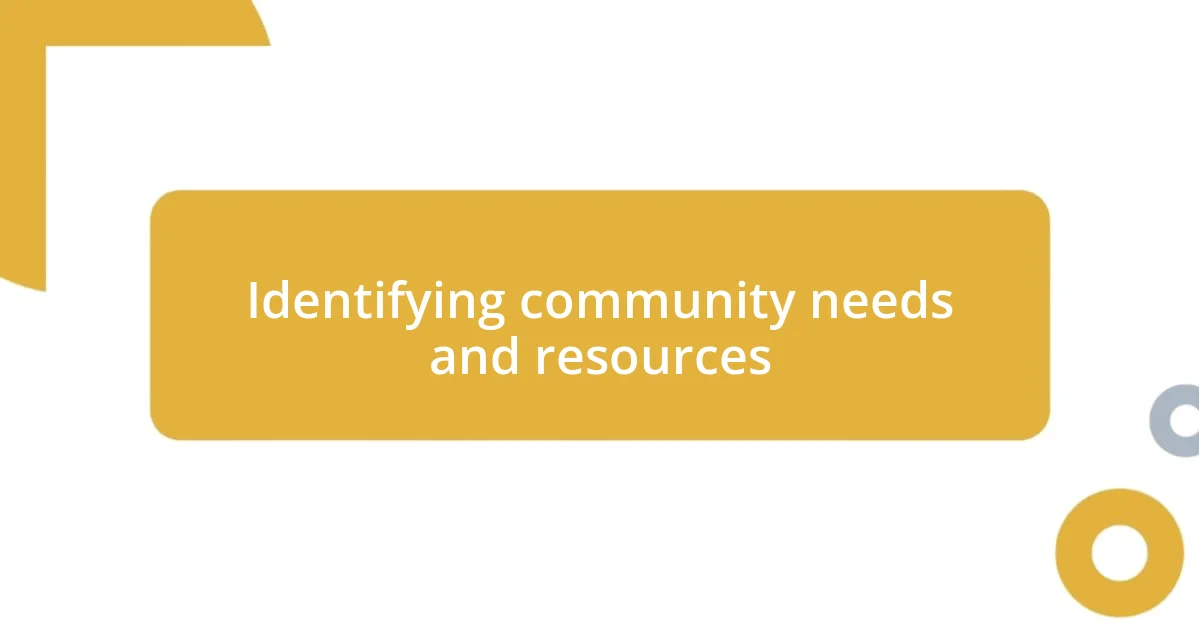
Identifying community needs and resources
Recognizing the unique needs and resources within a community is essential for effective prevention efforts. I remember attending a community forum where residents shared their concerns about mental health services. The authenticity in their voices reminded me how vital it is to listen. When people express their struggles, it creates an opportunity for collective understanding and action. It’s in these moments that we can truly identify what’s missing and how to fill those gaps.
In assessing resources, I’ve often turned to local organizations as a starting point. One time, I connected with a non-profit focused on youth outreach. It amazed me to see how many programs were available that many community members didn’t even know existed. This discovery highlighted the importance of communication in bridging community needs with available resources. Together, we created an event that brought awareness to these services, illustrating how collaboration can enhance our collective knowledge and solutions.
I’ve witnessed how a simple survey can unveil critical insights. My team once distributed a questionnaire about health services, and the responses were eye-opening. Many people indicated a lack of information about available programs, and this realization led us to launch informational workshops. The excitement of seeing attendees learn about services they didn’t know existed was incredibly rewarding. It reinforced my belief that proactive engagement is key to identifying not only needs but also the assets we already have within the community.
| Community Needs | Available Resources |
|---|---|
| Health education | Local health fairs |
| Mental health support | Counseling services |
| Substance abuse prevention | Support groups |
| Youth engagement | After-school programs |

Creating effective communication strategies
Creating effective communication strategies is essential for engaging the community in prevention initiatives. I recall a community meeting where we brainstormed ways to share important health information. One suggestion stood out: using storytelling to relay messages. It made me think about how our personal experiences can pack a powerful punch and draw others in. After all, who doesn’t connect with a heartfelt story?
In my own journey, I’ve tested various platforms to reach people effectively. Social media campaigns have proven to be a game-changer, especially when we shared video testimonials from community members. Do you remember a time when a story moved you to action? That’s what happened with one particular testimonial about overcoming addiction—the response was overwhelming. It encouraged others in similar situations to come forward, building a supportive dialogue that simply wasn’t happening before.
I also learned the importance of clarity in our communication. I once led a workshop where health pamphlets were distributed, filled with jargon that could confuse anyone not in the know. A participant candidly pointed this out, and it was a wake-up call for me. From that moment, I made it a goal to use straightforward language in all materials. It’s amazing how a simple shift can make your message resonate more deeply. When people understand the information, they are more likely to engage and take action. After all, what good is a great initiative if no one knows how to get involved?

Organizing community event activities
Organizing community event activities is a great opportunity for hands-on engagement. I once put together a health fair that combined entertainment with education, featuring local musicians and health booths. The energy was palpable, and as I watched families enjoy themselves while learning about wellness, it dawned on me how effective fun can be when it comes to serious topics. Did you ever notice how a lively atmosphere can open up conversations that might otherwise stay hidden?
Planning is crucial for success, and I’ve found that collaboration amplifies creativity. For instance, when I partnered with local schools for a youth engagement event, we brainstormed activities that would truly resonate with teens. Together, we developed interactive workshops on mental health and peer support, and seeing their excitement was so rewarding. It made me realize that when we tap into the interests of community members, attendance and participation naturally follow. Have you ever seen a room light up with enthusiasm when people feel included in the planning process?
Moreover, I learned the value of feedback post-event. After hosting a community cleanup, I circulated a simple feedback form, asking participants about their experiences. The insights were invaluable! One participant suggested adding a fun competition element next time, which sparked a whole new line of ideas for future events. This experience reinforced my belief that every interaction is a chance to guide our next steps, bringing the community even closer together. Isn’t it fascinating how each event can refine our understanding of what truly resonates with our community?

Building partnerships with local organizations
Building partnerships with local organizations has always been a cornerstone of my community engagement efforts. I remember when I first reached out to a local non-profit focused on mental health. We worked together to develop workshops tailored for those in need, and I was struck by how quickly trust was established. Have you ever noticed how collaboration can break down barriers? It’s like that moment when a new friendship blossoms—there’s a sense of shared purpose and camaraderie that feels invigorating.
One collaboration that stands out to me was with a local sports club. We organized a series of “Active Living” workshops that blended physical activity with wellness education. I was amazed to see how the enthusiasm for sports naturally attracted individuals who might not have engaged otherwise. The club’s members were not just participants; they became advocates for spreading health awareness in their own circles. How powerful is that? When organizations come together, it creates a ripple effect that enriches the community.
I’ve also learned to appreciate the diversity of thought that partners bring to the table. During one meeting with a community center, the team shared insights I hadn’t considered, revealing gaps in our approach. This openness wasn’t just refreshing; it was essential. It reminded me that building partnerships is not just about pooling resources—it’s about harmonizing different perspectives to tackle issues more effectively. Isn’t it remarkable how a blend of ideas can ignite a wave of innovation?
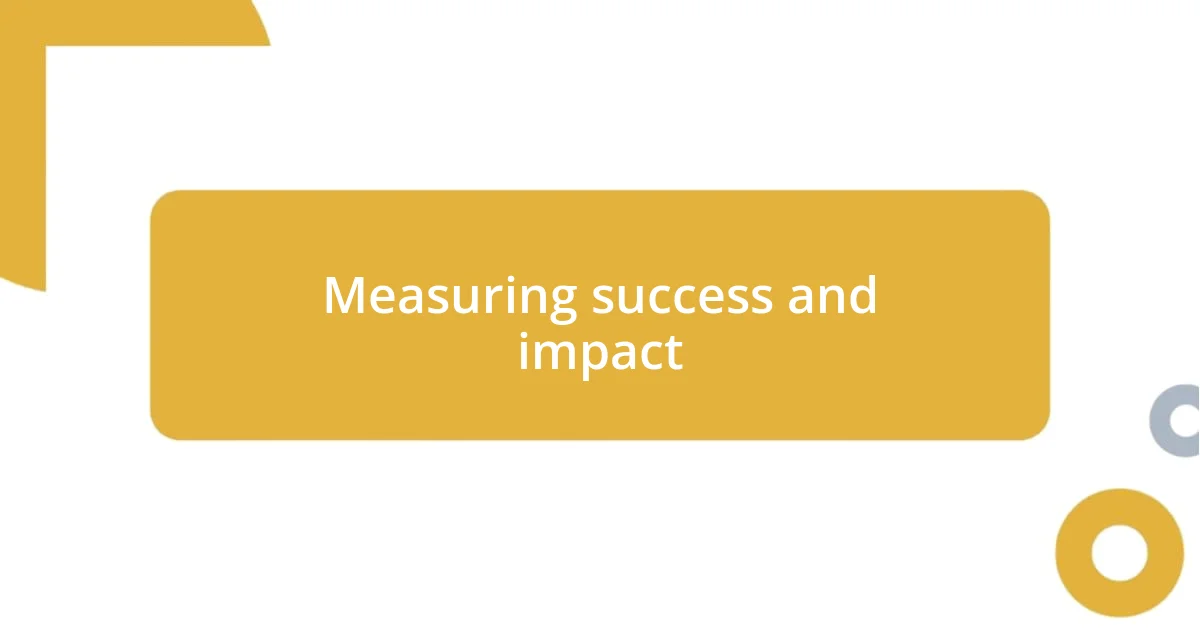
Measuring success and impact
Measuring success and impact in community engagement is not just about counting numbers; it’s about truly understanding the difference we make. When I organize events, I often reflect on the conversations and connections that form. Attending a community health fair, I once saw a mother approach a booth, her eyes brimming with curiosity about nutrition. That moment made me realize that success isn’t solely determined by attendance but also by the depth of engagement. How many meaningful conversations have we sparked? Those interactions often tell the real story of our impact.
To gauge this impact, I find that qualitative feedback is incredibly useful. After a workshop focused on mental health awareness, I asked attendees to share their stories anonymously. Reading through them, I was moved by the heartfelt responses mentioning how the session made them feel less alone. Seeing how our work resonates on a personal level was a humbling reminder that the effect of our efforts is often more profound than we can measure. Have you ever felt that sense of fulfillment when someone expresses gratitude for your contribution? It’s a powerful affirmation of our purpose.
Quantifying our achievements requires a blend of metrics and narratives. After running a series of health-focused community events, I compiled data showing increased participation rates over three months. But what really stood out to me was the anecdote from a participant who shared how she started a walking group after attending one of our gatherings. That combination of statistics and individual stories painted a fuller picture of our impact. Isn’t it intriguing how numbers can reflect real-life experiences, bridging the gap between data and human connections?

